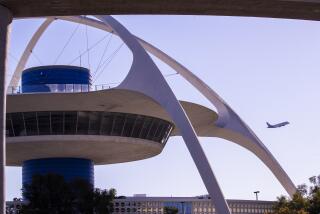Perilous Pattern
- Share via
Federal Aviation Administrator Donald D. Engen, speaking in the aftermath of the air collision near Cerritos that killed 82 people last August, said that the FAA “simply cannot tolerate” violations of the regulations governing flights of aircraft near busy airports.
That was in October. But the fact that near-collisions between airliners and small private planes continue to occur demands a much greater sense of urgency.
Last Saturday, in an incident reminiscent of the earlier accident near Cerritos, an Aeromexico jetliner and a small Cessna came dangerously close in the same general area. The next day a United Airlines jet reported a near-collision with a small plane six miles southwest of Los Angeles International Airport.
More than most people realize, the movement of private planes in crowded airspace is already governed by federal regulations. The approaches to LAX are included in a Terminal Control Area, or TCA, which no aircraft can legally penetrate without radio communication with controllers; within the TCA all planes must have radio beacons that transmit both horizontal location and altitude. Burbank, Ontario and Orange County airports all are surrounded by so-called ARSAs within which radio contact with controllers must be maintained.
As the continuing incidence of near-collisions demonstrates, however, this isn’t good enough. Aircraft operating along the fringes of a TCA, or even within an ARSA, are not required to have altitude-reporting equipment. In hazy Southern California it is easy for the best-intentioned pilot to stray unintentionally into restricted traffic zones. Existing radars do not always give a controller an accurate picture of all air traffic within his area of responsibility.
Needed corrective actions are by now quite obvious. The installation of better radars and the training of additional controllers must be speeded up. TCAs must be redrawn to make it easier for pilots to know where the boundaries are. Specified routes for departure and arrival of small planes from smaller airports within crowded areas like the Los Angeles basin would help immensely. All pilots should be tested on their knowledge of, and ability to comply with, rules governing flights in and around TCAs and ARSAs.
The most important single step, however, would be a requirement that all aircraft operating within 30 miles of a TCA or ARSA be equipped with transponders and altitude-reporting equipment. This would help controllers pinpoint the vertical as well as the horizontal positions of aircraft in their areas. Such equipment would also make it easier to track down errant pilots, and would make feasible the use of black boxes that would give airline pilots collision-avoidance warnings.
Finally, enforcement efforts must be stepped up. Maximum penalties--long-term suspensions and, indeed, revocations of pilots’ licenses--should be imposed more often. And if that proves to be an insufficient deterrent, jail terms should be authorized for deliberate violations.
The FAA is already moving on most of these fronts. But it isn’t moving fast enough. If congressional action is needed to speed up rule-making procedures, such action should be taken now. The present pattern of violations is dangerous, and absolutely unacceptable.
More to Read
Sign up for Essential California
The most important California stories and recommendations in your inbox every morning.
You may occasionally receive promotional content from the Los Angeles Times.













